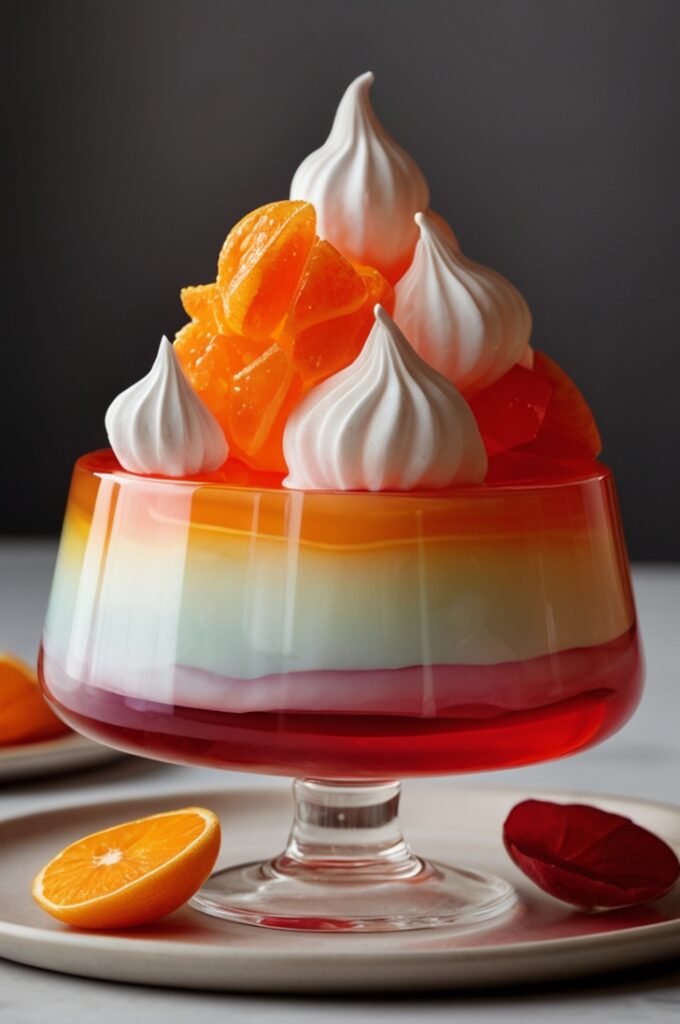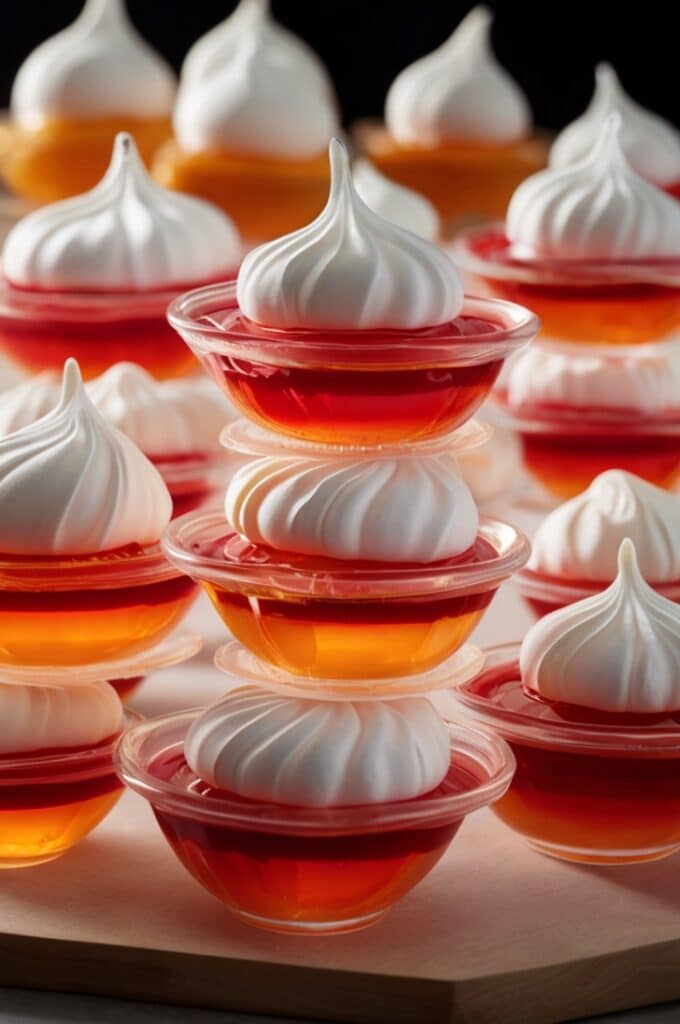The first time I encountered jello meringues at a high-end pastry competition in Paris, I stood there, jaw slightly ajar, watching as the judges’ expressions transformed from skepticism to delight. These vibrant, cloud-like confections seemed to defy culinary logic—how could something so weightless carry such intense flavor? I’ve spent fifteen years perfecting these treats, and lemme tell you, they’re worth every minute of that journey.
Jello meringues represent the perfect marriage between nostalgic childhood flavors and sophisticated pastry technique. These treats combine the airy, crisp texture of traditional meringues with the vibrant colors and playful flavors of jello powder, creating desserts that are simultaneously whimsical and elegant. They’re not just desserts—they’re edible art that transforms any table into a celebration.
1. Ingredients & Substitutions
Base Ingredients
- 4 large egg whites (room temperature)
- 1 cup granulated sugar
- 1/4 teaspoon cream of tartar
- 1 3-ounce package of flavored jello powder (any flavor)
- 1/2 teaspoon pure vanilla extract
- Pinch of salt
The egg whites are truly the foundation of your meringues—freshness matters tremendously here. Older eggs actually whip better for meringues, about 7-10 days old is perfect, as their proteins have relaxed slightly which improves volume. Don’t even think about using cartoned egg whites; they’ve been pasteurized and won’t whip properly.
For those with egg allergies, aquafaba (the liquid from canned chickpeas) serves as a remarkable substitute. Use about 3 tablespoons per egg white. The results aren’t identical—slightly less stable but still delightful—and they’ll need an extra 15 minutes in the oven.
Sugar crystals size affects your final texture. Superfine sugar (caster sugar) dissolves more quickly than regular granulated sugar, producing a smoother meringue. If you only have regular granulated sugar, pulse it in a food processor for 30 seconds to create superfine texture. Sugar alternatives like erythritol or monk fruit sweetener can work, but they’ll produce a slightly different texture and may not brown the same way.
Jello powder isn’t just for flavor—it’s adding acid, which stabilizes your meringues, plus it contributes those gorgeous colors that make these treats so distinctive. You can substitude with 1 teaspoon of powdered food coloring plus 2 teaspoons of flavoring extract and 1 tablespoon of cornstarch if you’re avoiding artificial ingredients. The texture will be slightly different but still delightful.
2. Step-by-Step Instructions

Preparation Phase
Preheat your oven to 225°F (107°C) and line two baking sheets with parchment paper. Humidity is the enemy of meringues, so choose a dry day to make these if possible. If your kitchen tends to be humid, turn on your air conditioning or dehumidifier about an hour before you begin.
Make sure your mixing bowl and whisk attachment are absolutely spotless—any trace of fat will prevent your egg whites from whipping properly. Wipe everything down with white vinegar if your unsure about residue. I’ve ruined batches by missing this simple step, and it’s heartbreaking to watch those whites refuse to whip.
Separate your eggs while they’re cold (easier), but then allow the whites to come to room temperature before whipping—they’ll expand much better that way. Give em at least 30 minutes on the counter.
Meringue Creation
- In a clean, dry bowl of a stand mixer fitted with the whisk attachment, combine the egg whites and cream of tartar. Beat on medium speed until foamy, about 1 minute.
- Gradually increase speed to medium-high and begin adding the sugar very slowly—literally a tablespoon at a time—while the mixer runs. This should take about 3-4 minutes to add all the sugar. Patience here pays off with stability.
- Once all sugar is incorporated, continue beating until stiff, glossy peaks form. You’ll know you’re there when the meringue stays in place if you turn the bowl upside down (carefully test this!). Under-beaten meringue won’t hold shape; over-beaten becomes grainy and breaks down.
- Sprinkle the jello powder over the surface and fold gently with a rubber spatula just until incorporated. Overmixing will deflate your hard-earned volume. About 12-15 folds should do it—the mixture should be marbled rather than uniform for the most striking visual effect.
Common mistake: Adding the jello powder too early can cause the meringue to collapse. Also, never use liquid food coloring as the additional moisture can ruin the texture.
Shaping and Baking
- Transfer the meringue mixture to a piping bag fitted with a large star tip (I prefer Wilton 1M). If you don’t have a piping bag, you can use a zip-top bag with the corner snipped off, or simply spoon dollops onto the baking sheet.
- Pipe 2-inch swirls or mounds onto the prepared baking sheets, leaving about 1 inch between each meringue. They won’t spread much, but they need airflow around them.
- Bake for 1 hour and 15 minutes, or until the meringues are dry to the touch and can be easily lifted from the parchment. Don’t open the oven door during baking—the temperature change can cause cracks.
- Once baking is complete, turn off the oven and leave the meringues inside with the door closed for at least an hour, preferably overnight. This gradual cooling prevents the shock that causes collapses and cracks.
For a variation with even more vibrant appearance, divide your meringue into portions before adding different flavors/colors of jello to each. Then marble them together in the piping bag for a tie-dye effect that’s absolutely showstopping.
3. Cooking Techniques & Science
The magic of meringues lies in understanding the transformation of egg white proteins. When you whip egg whites, you’re essentially unfolding these proteins and creating a network that traps air bubbles. The addition of sugar stabilizes this network by attracting water molecules, while acid (from cream of tartar or in this case, the citric acid in jello powder) helps strengthen the protein bonds.
Temperature control is absolutly crucial through this entire process. Meringues aren’t so much baked as they are dried. The low oven temperature (225°F) isn’t hot enough to caramelize the sugars significantly but instead slowly evaporates moisture without causing the meringue to brown too quickly or collapse.
The inclusion of jello powder introduces both flavoring and additional sugar (mostly dextrose), which affects the crystalline structure. This creates a slightly different texture than classic meringues—a bit more chewy toward the center while maintaining that crisp exterior that shatters delightfully when bitten.
Kitchen humidity dramatically impacts meringue success. On rainy days, meringues can absorb atmospheric moisture, becoming sticky or even collapsing. I once made these for an outdoor summer wedding and watched in horror as they began to weep in the humid air. If you live in a humid climate, consider adding 1 teaspoon of cornstarch to your sugar mixture as extra insurance.
The specialized copper bowl that traditional French pastry chefs use for meringues isn’t just showmanship—copper ions interact with egg white proteins, creating more stable foams. You can mimic this effect somewhat by adding that pinch of cream of tartar.
4. Serving & Pairing Suggestions
Jello meringues shine brightest when served as part of a thoughtfully composed dessert plate. Try placing them atop a pool of complementary curd or sauce—strawberry meringues with lemon curd create a beautiful sweet-tart contrast. The texture interplay between silky curd and crisp meringue is absolutely divine.
For presentation that really pops, arrange meringues of different jello flavors/colors in a spiral pattern on a white serving platter. The vibrant hues create an instant visual impact before anyone’s even taken a bite. Small edible flowers or mint leaves tucked between meringues add elegant detail.
These treats store remarkably well in airtight containers for up to two weeks, making them perfect prepare-ahead options for entertaining. However, once exposed to air—particularly in humid environments—they’ll begin absorbing moisture within hours. Serve them promptly after arranging.
Jello meringues pair beautifully with:
- Champagne or Prosecco (the acidity and bubbles complement the sweetness)
- Earl Grey or chamomile tea
- Vanilla bean ice cream (the temperature and texture contrast is spectacular)
- Fresh berries tossed in a little sugar and lemon juice
- Chocolate ganache for dipping (dark chocolate works especially well)
A particularly impressive serving method involves creating a “broken meringue” dessert: shatter several jello meringues over whipped mascarpone cream layered with macerated berries in clear glasses. The colors of the crushed meringue pieces create a stained-glass effect that never fails to elicit gasps from dinner guests.
5. Creative Variations

Filled Jello Meringue Sandwiches
Pipe meringue discs rather than peaks, and after baking, sandwich them with complementary fillings like white chocolate ganache or flavored buttercream.
Jello Meringue Pops
Insert food-grade lollipop sticks into larger meringue dollops before baking for charming dessert pops. These are particularly popular at children’s parties but sophisticated enough for adult gatherings too.
Deconstructed Jello Meringue Eton Mess
Crush jello meringues and layer with whipped cream and fresh fruit for a colorful twist on the classic British dessert. The tangy-sweet jello flavors add wonderful dimension to this simple dessert.
Meringue Tart Topping
Use jello meringue to top fruit tarts instead of traditional meringue—the flavored powder adds complementary notes to the fruit filling beneath. Torch lightly for dramatic effect.
Flavor Combinations Worth Trying:
- Lime jello meringues with coconut cream (think key lime pie flavors)
- Raspberry jello meringues with dark chocolate ganache
- Orange jello meringues with cardamom-infused whipped cream
- Blackberry jello meringues with lemon curd
- Pineapple jello meringues with rum-spiked cream
Conclusion
Jello meringues represent that perfect intersection of nostalgia and sophistication—a dessert that manages to be both whimsical and elegant simultaneously. The technical process respects classical pastry traditions while the flavor profile delivers unexpected joy through familiar childhood tastes.
What makes these treats truly special isn’t just their vibrant appearance or delightful texture contrast, but their versatility. From casual family gatherings to high-end dinner parties, they adapt effortlessly to any occasion. They’re also remarkably economical—transforming humble egg whites and basic pantry staples into something that looks and tastes far more luxurious than its ingredients suggest.
Master the basic technique, then allow yourself the freedom to experiment with flavors, presentations, and pairings. The jello meringue can be your culinary canvas, limited only by your imagination. And remember: even “failed” meringues can be crushed and repurposed into the most delightful crumbles or trifle layers—there’s no such thing as a true mistake in this recipe, just unexpected detours to new dessert possibilities.
FAQs
Why did my meringues crack or collapse?
Meringue cracking usually happens because of sudden temperature changes or over-beating. Ensure you’re letting them cool completely in the closed oven. If they’re collapsing, you might be underbaking them or your kitchen might be too humid—try adding cornstarch to help stabilize.
Can I make these meringues without artificial colors and flavors?
Absolutely! Substitute the jello powder with natural flavor extracts, a bit of acid (lemon juice or cream of tartar), and natural food colorings derived from vegetables or fruits. You’ll need to adjust the sugar slightly to compensate for what’s in the jello powder, around 2 extra tablespoons.
How far in advance can I make jello meringues for an event?
Jello meringues can be made up to two weeks ahead if stored properly in an airtight container in a cool, dry place. Don’t refrigerate them as the moisture will make them sticky. Assemble any composed desserts using the meringues just before serving.
My meringues are weeping sugar—what happened?
Sugar weeping (those little beads of syrup) typically means the sugar wasn’t fully dissolved during the whipping process. Make sure you’re adding the sugar very gradually and continue beating until the mixture feels completely smooth between your fingers—no graininess at all.
Can I freeze jello meringues?
While technically possible, freezing isn’t ideal for meringues as they can absorb moisture during the thawing process. If you must freeze them, do so in a single layer in an airtight container, then reheat in a 200°F oven for about 10 minutes to crisp them up again before serving.

